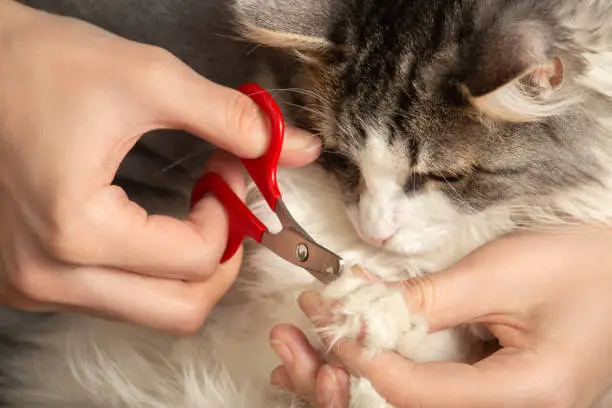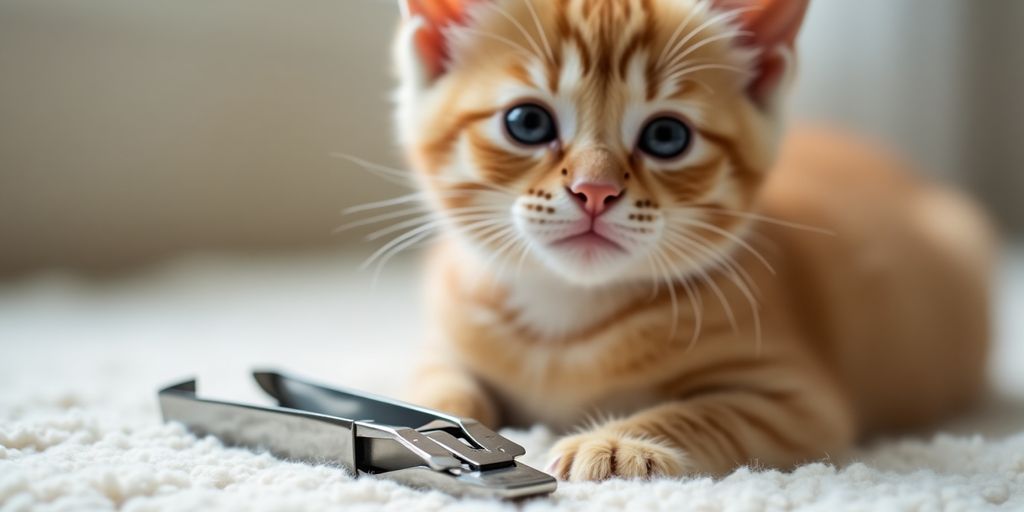Buying cat nail clippers can be a bit overwhelming for new cat owners. With so many options available, it’s important to know what to look for to ensure a safe and comfortable grooming experience for your feline friend. This guide will help you understand the different types of clippers, how to choose the right one, and tips for making nail trimming a positive experience.
Table of Contents
Understanding Different Types of Cat Nail Clippers

There are several types of cat nail clippers available, each with its own unique features and benefits. Understanding these types can help you make an informed choice.
Scissor-Style Clippers
Scissor-style clippers resemble regular scissors and are often considered the best option for many cat owners. They are easy to use and provide a clear view of how much nail you are cutting. Here are some advantages:
- Suitable for all cat sizes
- Strong and durable
- Minimal blade replacement needed, just occasional sharpening
Plier-Style Clippers
Plier-style clippers have a grip similar to pliers, making them comfortable to hold. They often come with safety features to prevent cutting too close to the quick. Benefits include:
- Ergonomic design for better grip
- Safety guards to avoid cutting the quick
- Some models include LED lights for better visibility
Guillotine-Style Clippers
Guillotine-style clippers have a small hole where you insert the nail, and a blade that slices down to cut it. While they can be effective, they require careful positioning of the nail. Key points include:
- Best for small to medium cats
- Risk of cutting too close to the quick
- Requires regular blade replacement
Nail Dremels
Nail dremels are a modern alternative that grinds down the nail instead of cutting it. They can be quieter and less intimidating for some cats. Considerations include:
- Gentle on the nails
- Slower than traditional clippers
- May scare some cats due to the noise
Each type of nail clipper has its pros and cons. It’s important to choose one that suits both your cat’s needs and your comfort level.
Choosing the Right Cat Nail Clippers for Your Feline Friend

When it comes to selecting the best cat nail clippers, it’s important to consider a few key factors to ensure a smooth experience for both you and your cat. With various types available, you want to choose the one that suits your needs and your cat’s temperament.
Consider Your Cat’s Temperament
- Calm Cats: If your cat is generally calm, you might opt for scissor-style or plier-style clippers.
- Anxious Cats: For more anxious felines, consider using a nail dremel, which can be less intimidating.
- Kittens: Young cats may benefit from smaller, lighter clippers designed specifically for their size.
Evaluate Your Own Experience Level
- Beginners: If you’re new to trimming, scissor-style clippers are often easier to handle.
- Experienced Owners: If you’re confident, you might prefer guillotine-style clippers for their precision.
- Safety First: Always ensure the clippers are sharp to avoid crushing the nail, which can happen with dull tools.
Safety Features to Look For
- Non-Slip Handles: Look for clippers with comfortable, non-slip grips to prevent accidents.
- Safety Guards: Some clippers come with safety guards to help avoid cutting too close to the quick.
- Easy to Clean: Choose clippers that can be easily cleaned to maintain hygiene.
By keeping these points in mind, you can make an informed decision that will help make nail trimming a more pleasant experience for your furry friend.
Step-by-Step Guide to Trimming Your Cat’s Nails

Trimming your cat’s nails can seem daunting, but with the right approach, it can be a smooth process. Here’s a simple guide to help you through it:
Preparing Your Cat for a Nail Trim
- Choose the Right Time: Make sure your cat is in a relaxed mood. Ideal moments are when they are sleepy or just waking up. Avoid times when they are active or hungry.
- Gather Your Tools: Have your sharp clippers and a styptic pencil ready. This ensures you’re prepared for any mishaps.
- Get Comfortable: Place your cat on your lap or a stable surface, ensuring they feel secure. Hold their paw gently, starting with the left paw if you’re right-handed.
Finding the Quick and Avoiding It
- Extend the Claw: Gently squeeze the joint behind the paw to extend the claw.
- Locate the Quick: Identify the quick, which is the pink part of the nail. Mark a safe distance of about 3-4 millimetres from it to avoid cutting too close.
Rewarding Your Cat After Trimming
- Clip the Nails: Position the clippers halfway between the nail and the quick. Clip in one smooth motion. If your cat gets anxious, take breaks and try again later.
- Offer Treats: After each successful trim, reward your cat with a treat. This helps them associate nail trimming with positive experiences.
Remember, patience is key! If your cat resists, don’t force it. Take your time and make it a pleasant experience for both of you. Regular nail care not only keeps your cat comfortable but also strengthens the bond between you and your pet.
Common Mistakes to Avoid When Using Cat Nail Clippers

When it comes to trimming your cat’s nails, there are several common mistakes that can lead to a stressful experience for both you and your feline friend. Avoiding these pitfalls can make the process smoother and safer.
Cutting Too Close to the Quick
One of the biggest mistakes is cutting too close to the quick, which is the sensitive part of the nail that contains blood vessels and nerves. If you accidentally cut into the quick, it can cause pain and bleeding. To prevent this:
- Always inspect the nail before cutting.
- Use clippers with a safety guard to help avoid over-trimming.
- If you’re unsure, trim a little at a time.
Using Dull Clippers
Using dull clippers can lead to a jagged cut, which may hurt your cat and make them more anxious about future trims. To ensure a clean cut:
- Regularly check the sharpness of your clippers.
- Replace them if they start to feel dull.
- Consider investing in high-quality clippers that stay sharp longer.
Forcing Your Cat to Stay Still
Trying to force your cat to stay still can create a negative experience. Instead, try these tips:
- Create a calm environment before starting.
- Use treats to reward your cat for good behaviour.
- If your cat is particularly anxious, consider doing one paw at a time and taking breaks.
When to Seek Professional Help
If you’re unsure about trimming your cat’s nails or if your cat is particularly anxious, it might be best to seek professional help. A groomer or veterinarian can assist with nail trimming and provide tips on how to make the process easier at home. Remember, the goal is to keep your cat comfortable and safe during nail care!
Tips for Making Nail Trimming a Positive Experience

Trimming your cat’s nails can be a smooth process if you approach it with care and patience. Here are some tips to help make nail trimming a positive experience for both you and your feline friend.
Creating a Calm Environment
- Choose a quiet space: Find a calm area in your home where your cat feels safe and relaxed.
- Limit distractions: Turn off loud noises and keep other pets away during the trimming session.
- Use soft lighting: A well-lit but soft environment can help your cat feel more at ease.
Using Treats and Praise
- Reward good behaviour: Offer treats before, during, and after the trimming to create a positive association.
- Use a soothing voice: Talk to your cat in a gentle tone to reassure them throughout the process.
- Celebrate small victories: Even trimming one nail is a success; give praise and treats to encourage your cat.
Starting Nail Trimming at a Young Age
- Introduce the clippers early: Get your kitten used to the sight and sound of nail clippers from a young age.
- Be consistent: Regularly handle your kitten’s paws to help them become accustomed to the process.
- Keep sessions short: Start with just a few nails at a time to avoid overwhelming your kitten.
By following these tips, you can help ensure that nail trimming becomes a routine part of your cat’s grooming, making it easier for both of you. Remember, patience and positive reinforcement are key to a successful nail trimming experience!
Wrapping Up Your Cat Nail Clipping Journey
In conclusion, choosing the right nail clippers for your cat is essential for a smooth and stress-free experience. With various styles available, from scissor to guillotine, it’s important to find one that suits both you and your feline friend. Remember to create a calm environment and take your time during the clipping process. Reward your cat with treats to make future sessions easier. By following these tips and using the right tools, you can keep your cat’s nails in check and ensure their comfort and safety.
Frequently Asked Questions
What type of nail clippers are best for my cat?
The best clippers depend on your skill level. Beginners might find scissor-style or grinding tools easier to use, while more experienced owners can try guillotine-style clippers.
How often should I trim my cat’s nails?
It’s a good idea to trim your cat’s nails every 2 to 4 weeks, depending on how quickly they grow.
What should I do if my cat won’t let me trim their nails?
If your cat is anxious, try to make the experience more positive with treats and breaks. You can also ask a vet or groomer for help.
How can I tell where to cut my cat’s nails?
Look for the quick, which is the pink part inside the nail. Trim just before it to avoid hurting your cat.
Are nail grinders better than clippers?
Nail grinders can be less scary for some cats as they grind the nail down slowly, but they can be noisy and take time to get used to.
What if I accidentally cut too close to the quick?
If you cut the quick, apply a styptic powder to stop the bleeding and soothe your cat. If it doesn’t stop bleeding, contact your vet.

